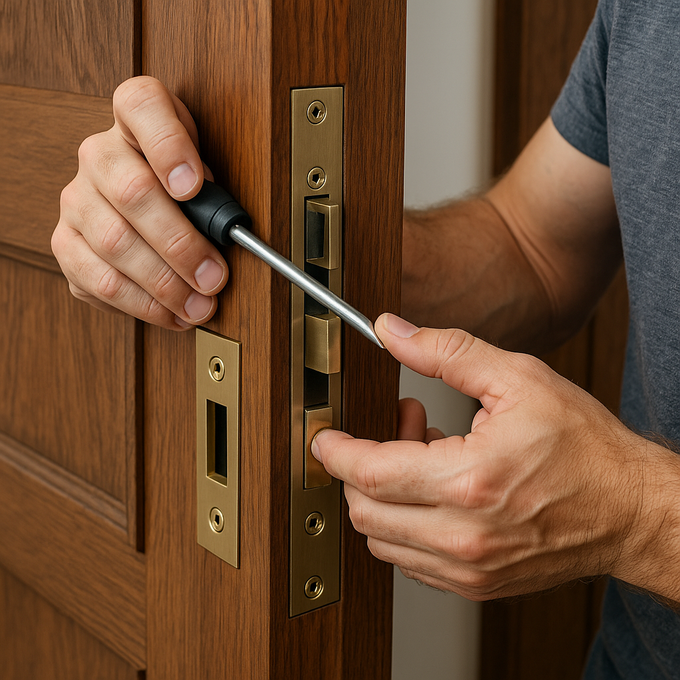
How to Rework a Mortise Lock 2025 Homeowner’s Guide
Posted by National Lock Supply on Oct 9th 2025
If your front door still has that solid “clunk” sound when it closes, chances are you’re dealing with a mortise lock,one of the most durable and classic lock designs ever made. These locks have been securing homes and buildings for over a century, and they can outlive the door itself if maintained properly. But like any mechanical system, a mortise lock can wear down, get stiff, or lose alignment over time.
Reworking a mortise lock doesn’t always mean replacing it. In most cases, it means restoring it,cleaning, realigning, lubricating, and, when necessary, upgrading the cylinder for better security.
This guide will walk you through exactly how to rework a mortise lock, when it’s worth doing yourself, and when it’s smarter to call a locksmith.
What a Mortise Lock Really Is
A mortise lock isn’t your typical doorknob lock. Instead of sitting on the surface of the door, it’s installed inside a deep pocket the “mortise”,cut into the edge of the door. The mechanism itself is housed in a metal box, usually made of brass or steel, and operates through a latch and deadbolt controlled by a key and lever.
When You Should Rework a Mortise Lock
A mortise lock doesn’t usually fail overnight; it gives you signs. If your key turns but doesn’t engage the bolt, the latch feels loose, or the key gets harder to insert, the internal mechanism is probably worn or dirty.
Here are the most common reasons to rework one:
- The key sticks or won’t turn smoothly.
- The latch doesn’t retract all the way.
- The bolt engages but the door won’t stay shut.
- You want to rekey or replace an old cylinder.
- You’re restoring a historic door and want to keep the original hardware.
If your mortise lock still feels solid but doesn’t work like it used to, a good cleaning and minor adjustment can make it feel brand new again.
How to Rework a Mortise Lock
Reworking a mortise lock involves a few key steps: removal, inspection, cleaning, repair, and reassembly. If you’re comfortable with light mechanical work, you can do the basics yourself. If not, a professional locksmith can handle it quickly and precisely.
1. Remove the Lock from the Door
Start by unscrewing the faceplate on the edge of the door. Gently slide out the mortise body,it’s usually held by two or three screws. If it’s been painted over or hasn’t been touched in decades, use patience, not force. Once out, keep all screws and trim in a small tray so nothing gets lost.
2. Open the Lock Case Carefully
Lay the lock body flat on a towel or soft cloth. Remove the small screws holding the case cover in place. Open it slowly; some springs inside can pop loose. Take note of how the internal parts fit together,snapping a quick photo with your phone helps for reassembly later.
3. Inspect and Clean the Internals
Inside you’ll find the latch, deadbolt, springs, and the cam that connects to the spindle (the part the knob turns). Use a dry brush to remove dirt and corrosion. For metal buildup, fine steel wool works well.
Lubricate moving parts lightly with graphite powder or a silicone-based lock lubricant,avoid oil-based products, as they attract dust and eventually gum up the mechanism.
4. Check for Worn or Broken Parts
If you notice a cracked spring or a lever that doesn’t return properly, replacements can often be ordered from locksmith suppliers. Antique mortise locks are surprisingly standardized, and many parts can be repaired or swapped.
If the key still turns freely without engaging the latch, the tailpiece or cam may be worn or misaligned. Adjust it so the bolt moves firmly in and out when the knob or key turns.
5. Reassemble and Test
Once everything is clean and lubricated, close the case, tighten the screws, and test the mechanism by turning the spindle or key before reinstalling it into the door. If it feels smooth and responsive, slide it back into the mortise pocket and secure the faceplate again.
You’ll be surprised at how much smoother it feels just from proper cleaning and lubrication.
Upgrading or Rekeying the Cylinder
Many homeowners take the opportunity during a rework to replace or rekey the mortise cylinder,the part where the key goes in. This is especially wise if you’ve moved into a new home or lost an old key.
If your mortise lock uses a skeleton key or older warded system, upgrading to a pin-tumbler cylinder gives you modern key control while preserving the classic appearance. It’s a simple retrofit most locksmiths can do in under an hour.
For newer mortise locks, rekeying the cylinder allows you to keep your hardware but change which key operates it, ideal for improved security without replacing the entire mechanism.
? Looking to modernize your door hardware? Explore our mortise lock and keypad lock collection, built for long-term reliability and classic appeal.
Common Mistakes to Avoid
A few simple missteps can turn a quick rework into a headache:
- Using oil-based lubricants: They attract dirt and eventually jam the lock.
- Forcing old parts: Many mortise locks are made of brass; over-tightening or bending can crack them.
- Skipping the photos: Always take a picture of the internals before disassembly; every model’s layout is slightly different.
- Mixing up screws: Faceplate screws are often finer than case screws; use the wrong ones and the latch may not seat properly.
If the lock still binds or the key doesn’t align after reassembly, it’s usually a sign of improper internal alignment. Take it apart again carefully and verify that springs and levers are seated correctly.
When to Call a Locksmith
If your mortise lock uses a skeleton key with intricate levers, or if it’s part of a historic property, hiring a locksmith is the best route. They have specialized tools for rekeying antique locks and can even fabricate replacement parts.
A locksmith can also convert your mortise system to accept modern keyways, add a deadbolt function, or install keypad entry upgrades without damaging your original door hardware.
? Want to keep your classic hardware but enjoy keyless access? Check out our keypad lock upgrades for mortise systems, the perfect balance of heritage and smart security.
Keeping Your Mortise Lock Working for Decades
Once reworked, a mortise lock can last another generation. To keep it performing smoothly:
- Lubricate the latch and keyway once a year with graphite powder.
- Avoid slamming the door; it stresses the latch mechanism.
- Wipe the faceplate with a soft, dry cloth; don’t use solvents or oil.
- If the key starts feeling rough again, clean and relubricate it before it gets worse.
Think of your mortise lock like an old engine: it doesn’t need constant attention, but it runs best when maintained regularly.
Final Thoughts
Reworking a mortise lock is part mechanical care, part craftsmanship. You’re not just fixing a door, you’re preserving a piece of your home’s history. A well-restored mortise lock feels heavy, solid, and reassuring every time you turn the key.
If your goal is to blend timeless design with modern ease, consider adding a keypad or smart mortise lock. You’ll get secure, keyless convenience without losing the aesthetic that makes traditional hardware so enduring.
 SAME DAY & EXPEDITED SHIPPING AVAILABLE
SAME DAY & EXPEDITED SHIPPING AVAILABLE





